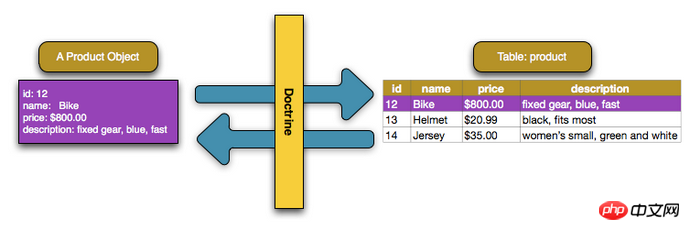資料庫和Doctrine ORM
對於任何應用程式來說,一個最常見且最具挑戰的任務,就是從資料庫讀取和持久化資料資訊。儘管symfony框架並未整合任何需要使用資料庫的元件,但卻緊密整合了一個名為 Doctrine 的三方類函式庫。 Doctrine的主要目標是提供你一個強而有力的工具,讓資料庫互動更輕鬆、更有彈性。
在本章,你將學習如何在Symfony專案中利用doctrine來提供豐富的資料庫互動。
Doctrine與symfony是完全解耦的,使用與否是可選的。本章講的全部是Doctrine ORM,目的是讓你把物件對應到關聯式資料庫(如 MySQL, PostgreSQL 和 Microsoft SQL)。如果你傾向於使用資料庫的原始查詢,這很簡單,可參考 如何使用Doctrine DBAL 一文的講解。
你也可以使用Doctrine ODM類別函式庫將資料持久化到 MongoDB。參考 DoctrineMongoDBBundle 以了解更多資訊。
簡單例子:一件產品(Product) ¶
#要了解Doctrine是如何運作的,最簡單的方式就是看一個實際應用。在本節,你需要配置你的資料庫,建立一個 Product 對象,把它持久化到資料庫,再取回它。
設定資料庫 ¶
在真正開始之前,你需要設定你的資料庫連線資訊。依照慣例,這部分資訊通常配置在app/config/parameters.yml 檔案中:
# app/config/parameters.ymlparameters: database_host: localhost database_name: test_project database_user: root database_password: password # ...
透過parameters. yml 來定義配置,只是一個慣例。配置Doctrine時,定義在那個檔案中的參數,將被主設定檔引用:
# app/config/config.ymldoctrine: dbal: driver: pdo_mysql host: "%database_host%" dbname: "%database_name%" user: "%database_user%" password: "%database_password%"
<!-- app/config/config.xml --><?xml version="1.0" encoding="UTF-8" ?><container xmlns="http://symfony.com/schema/dic/services" xmlns:xsi="http://www.w3.org/2001/XMLSchema-instance" xmlns:doctrine="http://symfony.com/schema/dic/doctrine" xsi:schemaLocation="http://symfony.com/schema/dic/services http://symfony.com/schema/dic/services/services-1.0.xsd http://symfony.com/schema/dic/doctrine http://symfony.com/schema/dic/doctrine/doctrine-1.0.xsd"> <doctrine:config> <doctrine:dbal driver="pdo_mysql" host="%database_host%" dbname="%database_name%" user="%database_user%" password="%database_password%" /> </doctrine:config></container>
// app/config/config.php$configuration->loadFromExtension('doctrine', array(
'dbal' => array(
'driver' => 'pdo_mysql',
'host' => '%database_host%',
'dbname' => '%database_name%',
'user' => '%database_user%',
'password' => '%database_password%',
),));透過把資料庫資訊分離到一個單獨檔案中,你可以很容易地為每個伺服器保存不同的版本。你也可以在專案外輕鬆儲存資料庫設定(或任何敏感資訊),舉例來說,就和apache中的設定資訊一樣。參考 服務容器外部參數如何設定 以了解更多。
現在Doctrine可以連接你的資料庫了,下面的指令可以自動產生一個空的test_project 資料庫:
$ php bin/console doctrine:database:create
如果你要用SQLite當資料庫,在path選項中設定你的資料庫路徑:
# app/config/config.ymldoctrine: dbal: driver: pdo_sqlite path: "%kernel.root_dir%/sqlite.db" charset: UTF8
<!-- app/config/config.xml --><?xml version="1.0" encoding="UTF-8" ?><container xmlns="http://symfony.com/schema/dic/services" xmlns:xsi="http://www.w3.org/2001/XMLSchema-instance" xmlns:doctrine="http://symfony.com/schema/dic/doctrine" xsi:schemaLocation="http://symfony.com/schema/dic/services http://symfony.com/schema/dic/services/services-1.0.xsd http://symfony.com/schema/dic/doctrine http://symfony.com/schema/dic/doctrine/doctrine-1.0.xsd"> <doctrine:config> <doctrine:dbal driver="pdo_sqlite" path="%kernel.root_dir%/sqlite.db" charset="UTF-8" /> </doctrine:config></container>
// app/config/config.php$container->loadFromExtension('doctrine', array(
'dbal' => array(
'driver' => 'pdo_sqlite',
'path' => '%kernel.root_dir%/sqlite.db',
'charset' => 'UTF-8',
),));建立一個Entity類¶
假設你正在建立一套程序,其中有些產品需要展示。即使不考慮Doctrine或資料庫,你已經知道你需要一個 Product 物件來呈現這些產品。在你AppBundle的Entity 目錄下創建這個類別:
// src/AppBundle/Entity/Product.phpnamespace AppBundle\Entity; class Product{
private $name;
private $price;
private $description;}這個類別——常被稱為一個“Entity”,表示一個保存著資料的基本類別 ——它很簡單,可以滿足程式中所需產品的業務需求。這個類別還不能被儲存到資料庫中——它只是個簡單的PHP類別。
一旦你學習了Doctrine背後的概念,你可以讓Doctrine為你建立entity類別。它將問你一些互動問題來幫你創造任意的entity:
$ php bin/console doctrine:generate:entity
新增映射資訊 ¶
Doctrine允許你以一種更有趣的方式來使用資料庫,而不只是把標量資料的行(rows)取出到陣列中。 Doctrine允許你從資料庫中取出整個 物件,同時持久化整個物件到資料庫中。對Doctrine來說要實現這些,你必須 映射 資料表到特定的PHP類別中,那些表的列(columns)必須被映射為對應PHP類別的特定屬性。

你要以「元資料(meatdata)」形式來提供這些映射信息,有一組規則可以準確告之Doctrine Product 類別及其屬性應該如何對應到 一個特定的資料表。這個metadata可以透過不同的格式來指定,包括YAML,XML或透過DocBlock註解(譯註:annotations)直接定義到Product 類別中:
// src/AppBundle/Entity/Product.phpnamespace AppBundle\Entity; use Doctrine\ORM\Mapping as ORM; /**
* @ORM\Entity
* @ORM\Table(name="product")
*/class Product{
/**
* @ORM\Column(type="integer")
* @ORM\Id
* @ORM\GeneratedValue(strategy="AUTO")
*/
private $id; /**
* @ORM\Column(type="string", length=100)
*/
private $name; /**
* @ORM\Column(type="decimal", scale=2)
*/
private $price; /**
* @ORM\Column(type="text")
*/
private $description;# src/AppBundle/Resources/config/doctrine/Product.orm.ymlAppBundle\Entity\Product:
type: entity
table: product
id:
id:
type: integer
generator: { strategy: AUTO }
fields:
name:
type: string
length: 100
price:
type: decimal
scale: 2
description:
type: text<!-- src/AppBundle/Resources/config/doctrine/Product.orm.xml --><?xml version="1.0" encoding="UTF-8" ?><doctrine-mapping xmlns="http://doctrine-project.org/schemas/orm/doctrine-mapping" xmlns:xsi="http://www.w3.org/2001/XMLSchema-instance" xsi:schemaLocation="http://doctrine-project.org/schemas/orm/doctrine-mapping http://doctrine-project.org/schemas/orm/doctrine-mapping.xsd"> <entity name="AppBundle\Entity\Product" table="product"> <id name="id" type="integer"> <generator strategy="AUTO" /> </id> <field name="name" type="string" length="100" /> <field name="price" type="decimal" scale="2" /> <field name="description" type="text" /> </entity></doctrine-mapping>
#一個bundle只可以接受一種metadata的定義格式。例如,不能把YAML的metadata定義並加入了註解(annotation)的PHP entity類別混用。
表名是可選的,如果省略,將自動取決於entity類別的名稱。
Doctrine允許你選擇廣泛的欄位類型,每一種都有自己的設定。可用字段類型的信息,參考 Doctrine字段類型參考。
你也可以查看Doctrine官方文件 Basic Mapping Documentation 以了解關於映射的所有細節資訊。如果你使用annotation,你需要為所有annotation加掛 ORM\ (例如 ORM\Column(...) ),這在Doctrine文件中並未寫明。你還需要去包容 use Doctrine\ORM\Mapping as ORM; 聲明,它可以 import(導入) ORM annotation前綴。
小心Entity類別名稱(或其屬性)同時也是一個SQL保留的關鍵字(如group 和user )。例如,如果你的entity類別名稱為 Group ,那麼,預設時,你的表名將會是group,這在一些資料庫引擎中可能會導致SQL錯誤。參考 Reserved SQL keywords documentation 以了解如何正確規避這些名稱。可選地,你可以任意選擇資料庫的schema,輕鬆地對應成不同的表名或列名。參考 Creating Classes for the Database 和 Property Mapping文件。
當使用其他一些「使用了annotations」的類別庫或程式(如Doxygen)時,你應該把@IgnoreAnnotation 註解加入類別中,來指示Symfony應該忽略哪個annotation。
例如,要避免@fn annotation拋出例外,新增下列註解:
/**
* @IgnoreAnnotation("fn")
*/class Product// ...建立entity之後,你應該使用以下指令來驗證映射(mappings):
$ php bin/console doctrine:schema:validate
產生Getters和Setters ¶
儘管Doctrine現在知道如何持久化Product 物件到資料庫,但類別本身還不具備真正用途。因為Product 只是一個有private 屬性的常規PHP類,你需要建立public 的getter和setter方法(例如getName() , setName($name) )以便在程式其他部分來存取它的屬性(其屬性是protected)。幸運的是,下面的指令可以自動產生這些模板化的方法:
$ php bin/console doctrine:generate:entities AppBundle/Entity/Product
這個指令可以確保 Product 類別所有的getter和setter都被產生。這是一個安全的命令列-你可以多次執行它,它只會產生那些不存在的getters和setters(即,不會取代現有的方法)。
重要提示下面這句話極為深刻,乃是活用Doctrine的關鍵。大家一定照做。
記得,doctrine entity generator產生的是簡單的getters/setters。你應該複審那些已生成的方法,在必要時,添加邏輯進去,以滿足你的程序之需求。
你也可以為一個bundle或一個entity命名空間內的所有已知實體(任何包含Doctrine映射資訊的PHP類別)來產生getter和setter:
# generates all entities in the AppBundle# 生成AppBundle下的全部entities$ php bin/console doctrine:generate:entities AppBundle # generates all entities of bundles in the Acme namespace # 生成Acme命名空间下的bundles的全部entities $ php bin/console doctrine:generate:entities Acme
建立資料表/Schema ¶
現在你有了一個包含映射資訊的可用Product 類,因此Doctrine確切地知道如何持久化它。當然,你還沒有對應的 product 資料表在庫中。幸運的是,Doctrine可以自動建立所有的資料表。要這麼做,執行以下指令:
$ php bin/console doctrine:schema:update --force
說真的,這條指令出奇的強大。它會比較你的資料庫理論上應該是 什麼樣子的(基於你的entities的映射資訊)以及實際上 它應該是什麼樣,然後執行所需的SQl語句來將資料庫的schema 更新到 它該有的樣子。換句話說,如果你新增了一個包含「映射元資料」(mapping metadata)的新屬性到Product 並執行此任務,它將執行所需的"ALTER TABLE" 語句,向已經存在的product 表格新增那個新欄位。
一個利用此功能之優勢的更佳方式是透過migrations,它允許你產生這些SQL語句,並把它們並儲存到migration類別中,這些類別能夠有序地運行在你的生產環境中,進而安全可靠地更新追蹤資料庫的schema改變。
不管你是否利用了資料庫遷移,doctrine:schema:update 指令只適合在開發環境中使用。它不應該被用於生產環境。
現在你的資料庫中有了一個全功能的product表,它的欄位與你指定的元資料相符。
持久化物件到資料庫 ¶
現在你有了一個Product實體和與之映射的product資料庫表。你可以把資料持久化到資料庫裡。在Controller內,它非常簡單。加入下面的方法到bundle的DefaultController。
現在你已經把Product entity 映射到與之對應的product 表中,你已經準備好把Product 物件持久化到資料庫中。在控制器裡面,這極為簡單。向bundle的 DefaultController 添加以下方法:
// src/AppBundle/Controller/DefaultController.php // ...use AppBundle\Entity\Product;use Symfony\Component\HttpFoundation\Response; // ...public function createAction(){
$product = new Product();
$product->setName('Keyboard');
$product->setPrice(19.99);
$product->setDescription('Ergonomic and stylish!'); $em = $this->getDoctrine()->getManager(); // tells Doctrine you want to (eventually) save the Product (no queries yet)
// 告诉Doctrine你希望(最终)存储Product对象(还没有语句执行)
$em->persist($product); // actually executes the queries (i.e. the INSERT query)
// 真正执行语句(如,INSERT 查询)
$em->flush(); return new Response('Saved new product with id '.$product->getId());}如果你正在跟進本例程,需要建立一個路由,並指向這個action,才能看到它運行。
本範例展示了在控制器中使用Doctrine的 getDoctrine() 方法。這是取出 doctrine 服務的快捷方法。若你在服務中註入此服務,即可在任何地方使用doctrine。參考 服務容器 以了解更多創建服務之內容。
深入分析前面的範例:
- #10-13行 在此處實例化,並且像其他常規PHP對象一樣去使用
$product物件。 - 15行 這一行取出了Doctrine的 entity manager 對象,它負責處理資料庫的持久化(譯註:寫入)和取出物件的過程。
- 18行
persist($product)調用,告訴Doctrine去 "管理"$product物件。它 沒有 引發對資料庫的請求。 - 21行 當
flush()方法被呼叫時,Doctrine會遍歷它管理的所有物件以決定是否需要被持久化到資料庫。本範例中,$product物件的資料在庫中並不存在,因此entity manager要執行INSERT請求,在product表中建立一個新行。
事實上,由於Doctrine了解你的全部被管理的實體,當你呼叫flush() 方法時,它會計算出所有的變更集合(changeset),並以正確順序執行語句。它利用準備好的快取語句以略微提高效能。例如,你要持久化總數為100的Product 對象,然後呼叫flush() 方法,Doctrine將用一個單一的prepare語法對象,來執行100次INSERT 請求。
如果 flush() 呼叫失敗,一個 Doctrine\ORM\ORMException 例外會被拋出。參考 Transactions and Concurrency(處理和並發)。
在建立和更新物件時,工作流程是相同的。在下一小節你將會看到,如果記錄已經存在於資料庫中,Doctrine是如何聰明地自動發出一個 Update 語句的。
Doctrine提供了一個類別庫,讓你可以程式化地載入測試資料到你的專案中(即,"fixture data",固定的資料)。參考 DoctrineFixturesBundle 以了解更多。
從資料庫取得物件 ¶
#從資料庫取回物件就更簡單了,舉個例子,假如你配置了一個路由,基於產品的id 來顯示特定的Product 物件:
public function showAction($productId){
$product = $this->getDoctrine()
->getRepository('AppBundle:Product')
->find($productId); if (!$product) {
throw $this->createNotFoundException(
'No product found for id '.$productId
);
} // ... do something, like pass the $product object into a template
// ... 做一些事,比如把 $product 对象传入模板}你可以使用@ParamConverter 快捷註釋,毋須編寫任何程式碼即可實現相同的功能。參考 FrameworkExtraBundle 以了解更多。
當你要查詢某個特定類型的物件時,你總是要使用它的」respository」(寶庫)。你可以認為Respository是一個PHP類,它的唯一工作就是幫助你從那個特定的類別中取出entity。對於一個entity類,要存取其寶庫,通過:
$repository = $this->getDoctrine()
->getRepository('AppBundle:Product');appBundle:Product 是快捷寫法,你可以在Doctrine裡隨處使用,以替代entity類的FQCN類名(如 AppBundle\Entity\Product )。只要你的entity存放在bundle的 Entity 命名空間下,它就會運作。
一旦有了Repository對象,你就可以存取它的全部有用的方法了。
$repository = $this->getDoctrine()->getRepository('AppBundle:Product');
// query for a single product by its primary key (usually "id")// 通过主键(通常是id)查询一件产品
$product = $repository->find($productId); // dynamic method names to find a single product based on a column value// 动态方法名称,基于字段的值来找到一件产品$product = $repository->findOneById($productId);$product = $repository->findOneByName('Keyboard');
// dynamic method names to find a group of products based on a column value
// 动态方法名称,基于字段值来找出一组产品$products = $repository->findByPrice(19.99);
// find *all* products / 查出 *全部* 产品$products = $repository->findAll();當然,你也可以使用複雜的查詢,參考 物件查詢 小節 。
你也可以有效利用findBy 和findOneBy 方法,基於多個條件來輕鬆取得物件:
$repository = $this->getDoctrine()->getRepository('AppBundle:Product'); // query for a single product matching the given name and price// 查询一件产品,要匹配给定的名称和价格$product = $repository->findOneBy(
array('name' => 'Keyboard', 'price' => 19.99)); // query for multiple products matching the given name, ordered by price// 查询多件产品,要匹配给定的名称和价格$products = $repository->findBy(
array('name' => 'Keyboard'),
array('price' => 'ASC'));渲染任何頁面時,你可以在調試工具列(web debug toolbar)的右下角看到許多查詢。

如果你點擊圖標,分析器(profiler)將會打開,顯示所產生的精確查詢。
如果你的頁面查詢超過了50個,圖示會變成黃色。這表示某些地方不大對勁。
物件更新 ¶
一旦從Doctrine取得了一個對象,更新它就很容易了。假設你有一個路由,把一個產品id映射到controller的updateaction:
public function updateAction($productId){
$em = $this->getDoctrine()->getManager();
$product = $em->getRepository('AppBundle:Product')->find($productId); if (!$product) {
throw $this->createNotFoundException(
'No product found for id '.$productId
);
} $product->setName('New product name!');
$em->flush(); return $this->redirectToRoute('homepage');}更新一個物件包含三個步驟:
- ##從Doctrine中取出物件;修改物件;呼叫entity manager的
- flush()
方法。
$em->persist($product) 是不必要的。回想一下,這個方法只是告訴Doctrine去管理或「觀察」 $product 物件。此處,因為你已經取到了 $product 物件了,它已經被管理了。
¶
刪除物件十分類似,但需要從entity manager呼叫remove() 方法:
$em->remove($product);$em->flush();你可能已經預期,
remove() 方法通知Doctrine你想從資料庫中刪除指定的entity。真正的 DELETE 查詢不會被真正執行,直到 flush() 方法被呼叫。
¶
你已經看到repository物件是如何讓你執行一些基本查詢而毋須做任何工作了:$repository = $this->getDoctrine()->getRepository('AppBundle:Product'); $product = $repository->find($productId);$product = $repository->findOneByName('Keyboard');當然,Doctrine 也允許你使用Doctrine Query Language(DQL)來寫一些複雜的查詢,DQL類似於SQL,只是它用於查詢一個或多個entity類別的物件(如product) ,而SQL則是查詢一個資料表中的行(如product )。
¶
假設你要查詢價格高於19.99 的產品,並且按價格從低到高排列。你可以使用DQL,Doctrine中類似原生SQL的語法,來建構一個用於此場景的查詢:
$em = $this->getDoctrine()->getManager();$query = $em->createQuery(
'SELECT p
FROM AppBundle:Product p
WHERE p.price > :price
ORDER BY p.price ASC')->setParameter('price', 19.99); $products = $query->getResult();如果你習慣了寫SQL,那麼對於DQL也會非常自然。它們之間最大的不同就是你需要就「select PHP物件」來思考,而不是資料表的行。正因為如此,你要從 AppBundle:Product 這個entity (可選的一個AppBundle\Entity\Product 類別的快捷寫法)來select,然後給entity一個p 的別名。
setParameter() 方法。當使用Doctrine時,透過「佔位符」來設定任意的外部值(上面範例的 :price),是個好方法,因為它可以防止SQL注入攻擊。
getResult() 方法傳回一個結果陣列。要得到一個結果,可以使用getSingleResult()(這個方法在沒有結果時會拋出一個例外)或getOneOrNullResult() :
$product = $query->setMaxResults(1)->getOneOrNullResult();
DQL語法強大到令人難以置信,允許輕鬆地在entity之間進行join(稍後會覆蓋relations)和group等。參考 Doctrine Query Language 文件以了解更多。
使用Doctrine's Query Builder進行物件查詢 ¶
#不去寫DQL的大字串,你可以使用一個非常有用的QueryBuilder對象,來建立那個字串。當你的查詢取決於動態條件時,這很有用,因為隨著你的連接字串不斷增加,DQL程式碼會越來越難閱讀:
$repository = $this->getDoctrine()
->getRepository('AppBundle:Product'); // createQueryBuilder() automatically selects FROM AppBundle:Product// and aliases it to "p"// createQueryBuilder() 自动从 AppBundle:Product 进行 select 并赋予 p 假名$query = $repository->createQueryBuilder('p')
->where('p.price > :price')
->setParameter('price', '19.99')
->orderBy('p.price', 'ASC')
->getQuery(); $products = $query->getResult();// to get just one result: / 要得到一个结果:// $product = $query->setMaxResults(1)->getOneOrNullResult();QueryBuilder物件包含了創建查詢時的所有必要方法。透過呼叫getQuery()方法,query builder將傳回一個標準的Query對象,可用來取得請求的結果集。
Query Builder更多信息,參考Doctrine的 Query Builder 文件。
把自訂查詢組織到Repository類別中 ¶
#前面所有的查詢是直接寫在你的控制器裡的。但對於程式的組織來說,Doctrine提供了一個專門的repository類,它允許你保存所有查詢邏輯到一個中心位置。
參考 如何建立自訂Repository類別 以了解更多。
設定 ¶
Doctrine是高度可設定的,雖然你可能永遠不會去關心那些選項。要了解Doctrine的設定信息,請參考 config reference。
Doctrine欄位類型參考 ¶
Doctrine配備了大量可用的欄位類型。每一個都能把PHP資料型別對應到特定的欄位類型中,無論你使用什麼資料庫。對於每一個欄位類型, Column 都可以被進一步配置,可以設定 length、nullable 行為,name 或其他選項。可用欄位類型的列表,參考 Mapping Types documentation。
Associations(關係) 和 Relations(關聯) ¶
Doctrine 提供了你所需要的管理資料庫關係(也被稱為關聯-associations)的所有的功能。更多信息,參考 如何使用Doctrine Associations / Relations。
總結 ¶
有了Doctrine,你可以集中精力到你的 物件 以及 如何把它應用到程式中,而資料庫持久化則是第二位。這是因為Doctrine允許你使用任何的PHP物件來保存你的數據,並且依靠「元資料映射」資訊來把一個物件的資料映射到一個特定的資料表之中。
Doctrine有很多強大的功能等著你去學習,像是relationships(關聯),複雜查詢和事件監聽。








